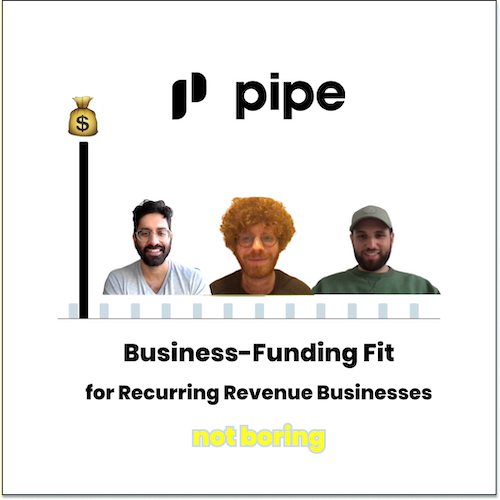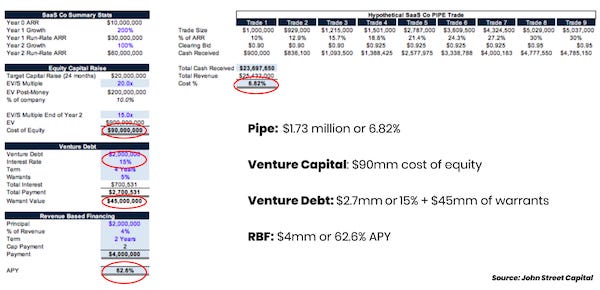Welcome to the 389 newly Not Boring people who have joined us since Monday! If you’re reading this but haven’t subscribed, join 18,850 smart, curious folks by subscribing here!
Today’s Not Boring is brought to you by…

Read on and I’ll tell you how Pipe is the smartest way to finance subscription businesses.
Hi friends 👋 ,
Happy Thursday!
I love my job.
In February, when Pipe announced its seed round, I knew that the company was going to be special. It solves a problem I’d been thinking a lot about and elegantly marries tech and finance. I was jealous I hadn’t thought of the solution!
In July, when Alex Danco interviewed founder and co-CEO Harry Hurst and Pipe raised another $60 million, I knew my initial hunch was right.
Last week, VC Guide included Pipe on its Wishlist of “companies we'd ‘quit our jobs for’ and ‘leave our 4-year vesting schedules early for’” alongside Not Boring favorites Stripe, DoNotPay, Figma, Mercury, Discord, and Webflow.
On Monday, I included Pipe in my essay on software that’s eating the financial markets.
Then on Tuesday, Harry and I decided to do a Not Boring deep dive on Pipe.
This is a company that I’ve admired from afar, and it’s surreal that I got to go behind the scenes. I’ve come away even more impressed. I can’t believe I get paid for this.
Speaking of which… I told you that when I write company deep dives, I would tell you whether I’m making money via CPA (I get paid when someone signs up for the product) or CPM (I get paid upfront no matter what happens). I had a choice on this one and I chose a CPA deal, because I think that any reader involved with a subscription business should work with Pipe.
Now let’s get to it.
Pipe: Business-Funding Fit

I know, I know… I’m getting paid to write this essay. But my reputation is more important to me than any one deal, and I’m willing to stake it on this: for any recurring revenue business, checking to see how much your recurring revenues are worth today on Pipe is a no-brainer. Not comparing Pipe to other forms of financing or discounting is a disservice to your shareholders, including yourself and your employees.
Pipe is building an entirely new asset class based on recurring revenue contracts. It’s not equity and it’s not a loan. Pipe lets businesses raise money today by selling their monthly or quarterly subscription cash flows directly through its platform. It’s as if you could convince all of your customers to pay you upfront, immediately in exchange for a small discount.
We’re going to go deep on the business, but I love making Not Boring readers money, so I’m going to tell you how to do that first. Here’s how it works:
Sign up for Pipe and connect your banking, payment processing, and accounting software.
Pipe instantly assigns your subscription revenue a rating.
Once approved, you access the Pipe Trading Platform and can see how much investors are willing to pay for your subscription revenue right now. On average, investors pay $0.90 - $0.95 for every dollar of revenue they buy on Pipe.
Choose how much or which of your contracts you want to trade from an auto-populated list.
Click “Payout” and receive the money within a day.
Pipe makes money like an exchange, charging a one-time maximum 1% fee to companies and another fee to investors.
From sign up to cash in bank in 24 hours:

That’s it. In less time than it takes to set up a Slack group, your company can raise as much money as it might in a months-long, dilutive venture capital fundraising process or in an equally painful venture debt raise that leaves you with liens on your business and warrants outstanding.
If you run or work for a recurring revenue business, you should see how much your monthly or quarterly cash flows are worth today. At the very least, it’s free and fun to check; at best, you might be able to fund your company’s growth without raising another round.
Who is Pipe for? Pipe works with companies that make recurring revenue - from SaaS to subscription content businesses, and everything in between. Pipe’s clients are small businesses with as little as $100k in ARR all the way up to publicly traded companies that make hundreds of millions in ARR. If your business makes recurring revenue, whether it’s venture-backed, bootstrapped, or public - chances are, Pipe can help you raise cheaper capital faster.
If that sounds like your business and you want to give it a try:
I only write deep dives about companies that I think can help your business. MainStreet, for example, has gotten Not Boring readers nearly $1 million back from the government already. But I also only write about companies that I think are fascinating to learn about. I’ve been excited about Pipe since long before Harry approached me about working together because of its potential to solve one of the biggest problems facing startups.
Business-Funding Fit
For such an innovative, smart group of people, startup founders all fund their businesses pretty much the same way they’ve been funding them for years. Every time they need to raise money to build or hire or grow, they sell shares in the company to venture capitalists in exchange for cash.
In early February, I was working to start a company and thinking a lot about the right way to finance it. Having just left a business that raised a lot of venture capital in part to sign leases and do construction, I was acutely aware that venture capital wasn’t the right money for everything that startups do.
This is not a “VC is bad” piece. VC is an incredibly important piece of the capital structure and often the only way to fund the ideas crazy enough to become the biggest companies in the world. The seven largest companies in the world by market cap -- Apple, Microsoft, Amazon, Google, Alibaba, Facebook, and Tencent -- all raised VC in their earliest days. Pipe itself has raised $66 million from top VCs like Craft Ventures and Tribe Capital in the eight months it’s been alive!
But it’s overused, largely because better forms of financing haven’t been easily accessible to startups and small tech businesses.
As I was noodling on the idea, Alex Danco dropped Debt is Coming and of course, he nailed it, putting into words all of the disparate concepts swimming around in my head in one compelling argument. If you’re as interested in this topic as I am, you need to read the whole thing, but I’ll try to boil it down:
There are two phases of a technical revolution: the Installment Period, when new things are being invented and tested and investments are more speculative, and the Deployment Period, when outcomes are more predictable and a dollar in should generate a known number out.
In many software businesses, we’re entering the Deployment Period.
The “VC model capital stack” of using VC exclusively to fund a business makes sense in the Installment Phase, but the Deployment Period requires different types of funding.
In this phase, when many businesses generate predictable recurring revenue and their marketing engines are finely tuned enough to predict how much it will cost to acquire a customer and how much that customer will spend over time, it makes sense to add some debt to the capital stack.
Tribe Capital’s Jonathan Hsu, whose excellent piece on Carta I’ve cited many times, captured the idea well when Danco interviewed him in July 2019:
When you acquire some customers and they start yielding revenue that behavior sounds an awful lot like buying a fixed income instrument and there is a lot of sophistication around how to value those cash flows. In some sense, what we’ve seen over the last decade is that software enables a whole new business model – recurring revenue – which is both good for customers and is good for investors. It’s good for investors because it becomes more “predictable” in the sense that it starts to look more like a fixed income yielding asset and thus more amenable to traditional financial techniques and thus potentially “in scope” for a wider set of investors.
It’s a huge vote of confidence, then, that Tribe invested in Pipe this July. And that when Danco interviewed Hurst in that same month, he titled the article “It’s Not Debt, It’s Better.”

What Danco and Hsu both realized in two steps is:
There should be a better way to finance recurring revenue businesses.
Pipe is that better way. Even better than debt.
Pipe solves the problem that both Hsu and Danco alluded to: right now, the way that startups fund themselves doesn’t match their business models or maturity. Product-Market Fit gets most of the headlines. Product-Founder Fit is an up-and-comer. But Business-Funding Fit -- funding each business with the right type of capital -- is an equally important piece of the puzzle when it comes to generating outsized returns over time.
As we discussed in Tencent: The Ultimate Outsider, Will Thorndike analyzed eight of the businesses that most outperformed their peers and the market over decades in his book, The Outsiders. The thing that they all had in common was that their CEOs were all excellent capital allocators. They were thoughtful about how they funded their businesses and how they spent the money they had.
Not every CEO is a great capital allocator. Most aren’t. But in an interview with Alex Danco, Hurst noted that new tools make it easier to find Business-Funding Fit:
Based on the fact that most founders are builders, not CFOs, it’s a fair assumption that most founders aren’t naturally skilled capital allocators and so aren’t aware of all of the alternative methods large companies utilize to finance their businesses. What I see happening in B2B fintech is a sort of ‘consumerization’ of these previously unknown and unavailable methods of financing to the benefit of all founders, at all stages.
Before, a founder could say with a straight face, “Look, I’m a product person, not a finance person.” Now, there’s no excuse not to take an hour to see if Pipe or other alternative financing methods could help them grow more efficiently and keep more equity in the hands of the people building the company.
For recurring revenue businesses, Pipe is Business-Funding Fit in a box. Pipe provides those companies with a new way of financing themselves that is cheaper and faster than any existing alternative.
Pipe is the Lowest Cost of Capital for SaaS & Subscription Businesses
There are four ways that a business with recurring revenue could traditionally finance itself:
Equity / VC. As discussed above, most startups fund themselves by selling equity to venture capitalists. It typically makes sense for startups to have VC in the mix because startups are risky and banks won’t underwrite them at earlier stages.
Debt / Venture Debt. When businesses start generating fairly stable cash flows, they can borrow money against them from a bank or a venture debt firm. Loans and venture debt normally comes with a higher interest rate, liens on the business, and warrant coverage that gives the lender the right to buy shares at a specified price and is therefore dilutive.
Revenue-Based Financing (RBF) / Merchant Cash Advance (MCA). Companies like Clearbanc, Stripe, and Square offer financing to businesses based on their understanding of those businesses’ payments and expenses. RBF / MCA sits somewhere between equity and a loan. It’s not collateralized by assets in the business like a loan and doesn’t dilute shareholders like equity, but it requires payment based on a percentage of revenue. Think of this like Kevin O’Leary’s deals on Shark Tank.
Discounts for Annual Subscriptions. While this isn’t typically thought of as a form of financing, most subscription businesses offer customers a discount off of the monthly price in exchange for paying for a full year upfront. These companies are essentially borrowing money from customers at a high interest rate (typically 15-30%).
Pseudonymous business analyst John Street Capital did a deep dive comparing Pipe to the three traditional types of external financing in Recurring Revenue: The Rise of an Asset Class. Based on his assumptions, he found that Pipe was the cheapest cost of capital for a fast-growing, subscription-based business.

Again, the full post is worth a read if you’re choosing among the different financing methods. The takeaway is that Pipe costs less than venture debt or RBF in terms of rate, and much less than both venture capital and venture debt (when warrants are included) in terms of value given to investors, assuming that the business is growing and trades at market multiples. One commenter pointed out that with interest rates where they are, venture debt is going for 5% in some cases, but even at 5%, when warrants and liens on the business are considered, Pipe is much cheaper.
The comparison doesn’t even take into account the fact that fundraising, whether venture capital or venture debt, is a time-consuming, defocusing process. When a company is in fundraising mode, it often requires the full focus of the senior leadership team, pulling them away from activities that would help grow the business. And the legal fees can be killer!
What about just discounting to get customers to pay annually instead of monthly? Pipe wins here, too.
I did an informal survey of some subscription businesses that came to mind.

Even at $0.85 cents on the dollar, which is a much lower bid than most of Pipe’s customers trade at, Pipe would still be a cheaper financing method than the discounts that leading subscription businesses offer their customers to pay the full annual amount upfront. At 16.67 - 30.95%, those discounts are effectively incredibly expensive loans!
Plus, according to a Pipe customer survey, annual discounts only entice ~7% of customers to pay upfront instead of monthly. Just like the subscription businesses want the money upfront, their customers want to keep their money as long as possible, and so the annual discount trade rarely clears. If a subscription customer is a SaaS company and wanted to be really smart, I suppose they could trade their own subscriptions on Pipe for a 5-10% discount to annualized cash flow and then use that cash to pay for the other subscription upfront saving 20-30% 🤯
There’s one more important thing to note on annual discounts versus Pipe. Subscription businesses are valued on a multiple of top line revenue. Because of the way accounting works, when a business offers an annual discount, they are giving away top line revenue, but when they sell monthly subscriptions at full price and sell their recurring revenue on Pipe, they get to keep the full amount in the top line, supercharging their valuation.
Let’s take Slack, the company that I love so much despite the fact that its performance is dragging my entire portfolio down. If 7% of its customers choose to pay annually with a 16.67% discount, and it trades at a 19.9x EV/LTM Revenue multiple, it’s giving up $200 million in enterprise value by discounting instead of using Pipe!

That’s enterprise value that I, as a beleaguered shareholder, would love to have in my pocket.
Why Now: Pipe’s Flywheel
By now, we’ve established that Pipe should exist. It’s a brilliant idea that helps businesses fund themselves more efficiently and gives investors access to a new asset class that strips out all of the noise and directs those sweet, sweet recurring revenue cash flows right into their veins.
But it’s fucking hard to start a new asset class on a new exchange. It’s a two-sided marketplace problem: you need to both convince companies to sell their revenues and investors to buy them. That’s part of the reason that Pipe has raised so much money for a company its size. When Pipe announced its seed extension, Hurst highlighted this challenge:
We are connecting SaaS companies with investors, and in order to do that, liquidity needs to be in the marketplace. Only a small portion of the new financing will go to core operations—we run lean and mean—and a vast majority of the money will go into the marketplace, so as more SaaS companies sign up, there will be liquidity.
This is what the challenge looks like in practice:
Pipe needs to simultaneously attract companies willing to sell their recurring revenue and investors willing to buy it.
If it attracts a lot of companies and few investors, there will be more supply than demand and investors’ bids will be low - maybe they would pay $0.70 for $1 worth of revenue.
If bids are low, companies will leave and find better ways to fund the business, including offering bigger discounts to entice customers to pay upfront.
If Pipe attracts a lot of investors but few companies, there won’t be enough recurring revenue streams for investors to buy, and it will remain small.
One way to solve that in the early days is by buying liquidity - supporting the market by either buying recurring revenue streams itself or by paying more to bring companies onto the platform. Pipe is good enough at what it does, and well-financed enough, that it would have solved the chicken-and-egg problem either way, it just would have cost a lot upfront.
The only thing better than being good, though, is being good and lucky. Almost all of the factors that I wrote about in Software is Eating the Markets are coming together to smash through Pipe’s liquidity challenge.
SaaS and subscription businesses, from Zoom to Peloton to paid newsletters, are growing incredibly fast during COVID, creating more supply of recurring revenue streams.
Interest rates are at all-time lows, and investors are looking for yield.
Investors are particularly interested in SaaS and subscription business companies as evidenced by their equities’ outperformance in the market, and are more than happy to buy exposure to the cash flows directly without paying a huge multiple.
Pipe sits right in the middle of those two, providing an exchange on which companies can earn cash today and investors can buy the revenue streams they want.
More liquidity means more transactions, which builds trust in the asset class, and more bids competing for revenue streams means better bids, which attracts more companies.
This is Pipe’s flywheel and network effect: more bids → better prices → more companies → more bids.

In many ways, Pipe’s flywheel is like Opendoor’s. More transactions lead to better pricing which leads to more transactions.
Pipe is the cheapest and most efficient capital for SaaS and subscription businesses today. The beauty of a marketplace or exchange, though, is that once you get it going, it just keeps getting better over time. As Pipe continues to turn the flywheel, it will become even more of a no-brainer tool in the SaaS and subscription business financing toolkit. And it’s just getting started…
Matching Financing to Businesses
Pipe is just getting started.
First, it focused just on SaaS businesses.
Then, it opened up to all subscription businesses.
Next, Pipe is developing a Recurring Revenue Offering that allows companies to pre-sell future subscription revenue to raise even more money.
In the future, Pipe will provide a greater and greater number of financing alternatives custom built for tech businesses.
Pipe is in the business of creating Business-Funding Fit. Its skills -- pulling in companies’ financial data via APIs, assigning ratings based on that data, attracting investors, providing liquidity, and managing seamless ongoing financial transactions -- will be extensible to many more subscription-based business models over time.
Think internet bills, cable bills, cell phone bills, membership fees, fitness app memberships, creator economy subscriptions… if it’s a digital subscription, Pipe should be able to turn MRR into ARR and provide access to cheap, efficient capital. If I ever turn on paid subscriptions for Not Boring, Pipe is going to be my first call.
If you run a SaaS or digital subscription business, sign up for Pipe to keep more equity in your team’s pockets.
If you work for a SaaS or digital subscription business, tell your CEO and finance team to sign up for Pipe and then ask for a raise.
If you’re an investor with SaaS or digital subscription businesses in your portfolio, tell them to sign up for Pipe to avoid unnecessary dilution in future rounds and keep your pro rata allocation to make more investments, and then tell those founders to sign up for Pipe.
Pipe is going to be one of the most transformative companies of the next decade. You heard it here first.
Thanks to Harry for partnering with me to turn this around on a tight timeline!
If you’re interested in a behind-the-scenes look at Not Boring, I spoke to my friend, the Media Operator himself, Jacob Donnelly on his podcast. Give it a listen 👂🏻
Thanks for listening, and see you Monday,
Packy









